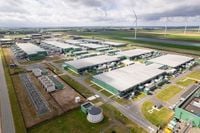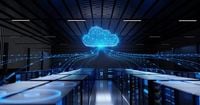On August 18 and 19, 2025, a series of reports and analyses from major financial institutions, energy experts, and industry observers painted a striking picture of the economic and infrastructural upheaval being wrought by the rapid adoption of artificial intelligence (AI) across the United States. The story unfolding is one of immense opportunity—and equally profound disruption—touching everything from Wall Street to the nation’s power grids.
According to a new assessment by Morgan Stanley, AI’s breakneck progress could add between $13 trillion and $16 trillion in value to the S&P 500, potentially boosting the index’s market capitalization by as much as 29%. As reported by Business Insider, the bank’s strategists believe that agentic AI—systems capable of making decisions with little human supervision—and humanoid robots could together contribute more than $900 billion to this value. Sectors like consumer staples distribution, retail, real estate, and transportation are expected to see the most dramatic gains, with long-term value creation in these industries projected to at least double their pre-tax income by 2026.
This staggering growth, however, comes with a cost. Morgan Stanley’s analysis suggests that AI could impact around 90% of existing jobs, leading to sweeping changes in the workforce. While some workers may be able to upskill or transition into new roles—think “AI supply chain analyst” or “AI ethicist”—others may face displacement, especially in white-collar professions. The bank noted, “If history is any guide, AI could result in net job creation, though there could still be periods of displacement.” Goldman Sachs, for its part, has previously estimated that AI could automate up to 300 million full-time jobs, with administrative and legal roles among the most at risk.
This theme of disruption was echoed in a candid discussion on 24/7 Wall St., where commentators Doug McIntyre and Lee Jackson highlighted the growing obsolescence of high-earning professional roles. “There are gonna be a whole category of high earning people who are not gonna have jobs,” McIntyre said, referencing software engineers, Wall Street analysts, and legal researchers. “Those people will not be needing, you do not need a human to write an appellate brief once you’ve got AI and it has access to all the law, books and history.” The conversation drew a stark parallel to the early 20th-century transition from horse-drawn carriages to automobiles, which wiped out entire industries in a matter of decades.
But the AI revolution isn’t just reshaping the labor market—it’s also sending shockwaves through the nation’s energy infrastructure. With AI server farms and data centers proliferating at a record pace, demand for electricity is soaring. Eric Schmidt, former chairman of Google, recently predicted that “99% of all the electricity produced in the world will go towards AI server farms and training.” While that figure is likely hyperbolic, the underlying message is clear: the competition for electricity is becoming fierce.
Utility and energy companies are now seen as major beneficiaries of the AI boom. “If you look at utility companies… you’ve got to get [solar and wind] online. You don’t have any choice,” McIntyre asserted. Even coal, which has fallen out of favor in recent years, could see a resurgence as the industry scrambles to meet surging demand. “There’ll be very few losers in energy,” he added, likening the rush to invest in power generation to the gold rush of the 19th century.
This bullish outlook for the energy sector was reflected in Vistra Corp’s latest earnings report, published by Seeking Alpha on August 18. The company posted a 12% increase in earnings per share and a 10.5% rise in revenue for the second quarter, with adjusted 2025 EBITDA guidance between $5.5 billion and $6.1 billion. These results were buoyed by a record PJM auction price and the expansion of Vistra’s natural gas fleet, both of which enhance near-term earnings visibility. However, not all is smooth sailing: the company faces policy uncertainty beyond 2027 and its low renewable energy share could limit its ability to secure long-term, carbon-neutral power purchase agreements. Moreover, tariffs and high leverage present additional headwinds, especially if capital expenditures on AI infrastructure are curtailed.
The strain on the country’s electrical grid is becoming increasingly apparent. On August 19, Monitoring Analytics—a U.S. electricity researcher—issued a stark warning: the current capacity in the PJM regional transmission organization, which covers 13 states from Virginia to Illinois and hosts the nation’s highest concentration of data centers, is “not adequate to meet the demand from large data center loads and will not be adequate in the foreseeable future.” The report called on large data centers to provide their own power generation, arguing that failure to address the issue will result in “very high costs for other PJM customers.” The grid operator itself acknowledged the “unprecedented growth in electricity demand” driven by AI and digital infrastructure, calling for enhanced load flexibility to maintain both reliability and affordability.
The convergence of these trends—explosive AI-driven productivity, massive job market churn, and mounting energy demands—has left investors, policymakers, and workers alike grappling with a new reality. The stock market may be poised for a historic windfall, but the transformation is not without risks. As one 24/7 Wall St. commentator put it, “People say, well, there’ll be guardrails on AI. The answer to that is no, it will not. This is a war. Among the big tech companies over who gets the lead.”
For those entering the workforce, the message is sobering. “People coming out thinking they would have a job out of college… those people are all on their way to Chipotle. And that’s not to eat, it’s to work,” McIntyre quipped, underscoring the urgency for upskilling and adaptability in an era where traditional technical skills may no longer offer a competitive edge.
Yet, as history has shown, technological revolutions can also create new opportunities. The rise of the automobile, after all, gave birth to entire industries and millions of jobs that no one could have foreseen. Whether AI’s impact will be similarly generative—or more disruptive—remains to be seen. What’s certain is that the race is on, not just for technological supremacy, but for the power, people, and policies that will shape the next chapter of the American economy.


